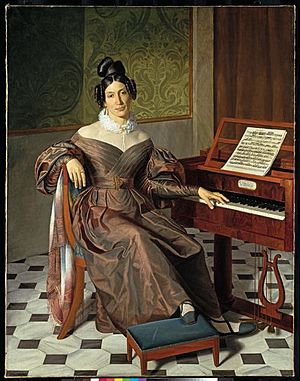Isabella Colbran facts for kids
Isabella Angela Colbran (born February 2, 1785 – died October 7, 1845) was a famous Spanish opera singer. In her home country, she was known as Isabel Colbrandt. Many people described her as a powerful soprano singer. Some even thought she was a mezzo-soprano with a very high range. She worked closely with the opera composer Gioachino Rossini. Together, they created many opera roles that are still performed today. Isabella and Gioachino got married on March 22, 1822. She also wrote four collections of songs herself.
Contents
Colbran's Time in Naples
Isabella Colbran was born in Madrid, Spain. She studied music in Paris with a teacher named Girolamo Crescenti. By the time she was twenty years old, she was famous all over Europe for her amazing voice.
She moved to Naples, Italy. Naples was a very important city for music in the 1700s and 1800s. The Teatro di San Carlo was a famous opera house there. Many great singers performed at this theater. It was a dream place for talented singers to perform.
Colbran became the main female singer, or prima donna, at the Teatro di San Carlo. She was admired by the King of Naples and loved by the public. The theater's manager, Domenico Barbaia, was also a big fan.
To make the most of Colbran's talents, Barbaia hired Gioachino Rossini. Rossini signed a seven-year contract to write operas for the company. When Rossini arrived in Naples in 1815, he wrote the main role in Elisabetta, regina d'Inghilterra (Elizabeth, Queen of England) just for Isabella.
His next opera in Naples was Otello, ossia il Moro di Venezia. In this opera, Colbran sang the role of Desdemona. This opera became very popular. It showed Colbran at the peak of her singing abilities. People wanted to see her perform more and more. Even though her voice started to show signs of strain, Colbran continued to have a busy career. She created many important roles in operas written by Rossini for Naples. These included Armida (in Armida), Elcia (in Mosè in Egitto), Zoraide (in Ricciardo e Zoraide), Ermione (in Ermione), Elena (in La donna del lago), Anna (in Maometto II), and Zelmira (in Zelmira).
Colbran's Life in Bologna
Isabella Colbran and Gioachino Rossini started working together in 1815. Their artistic partnership soon turned into a romantic one. In 1822, Colbran moved with Rossini to Bologna, Italy. Rossini was seven years younger than her. They got married there.
Isabella was very sad when her father passed away. Rossini felt for her. He ordered a sculpture for her family's mausoleum. It showed a woman crying at the foot of her father's grave.
The couple traveled to Vienna and later to Venice. In Venice, Rossini composed the opera Semiramide. Colbran sang the main role in this opera. Even though Semiramide was a huge success, Colbran's performance did not impress the public as much. This was because her voice was starting to weaken. In 1824, she visited London for a performance. She was paid a lot of money, but critics did not like her singing. After a difficult performance as Zelmira in 1824, she stopped performing on stage. She was about 42 years old.
Colbran and Rossini separated in 1837. Rossini then started a new relationship with Olympe Pélissier in Paris. Colbran's health began to decline. She continued to live on her father's estate in Castenaso, near Bologna. Rossini kept sending her financial support.
Isabella Colbran died in 1845 when she was 60 years old. She was buried near Bologna, next to her parents and Rossini's parents. Rossini married Olympe Pélissier the following year. Throughout his life, Rossini always said that Colbran was the best singer of his music.
Her Singing Voice
People described Isabella Colbran's voice as "sweet" and "mellow." It had a rich sound in the middle part of her vocal range. The music Rossini wrote for her shows that she was a master of many singing techniques. These included trills (quick changes between two notes), half-trills, staccato (short, detached notes), legato (smooth, connected notes), and quick jumps between notes. Her vocal range was very wide. It went from a low F-sharp to a high E, and sometimes even a high F.
Her Compositions
Isabella Colbran wrote four collections of songs. She dedicated these songs to important people. One collection was for the Empress of Russia. Another was for her teacher, Crescenti. She also dedicated one to the Queen of Spain and one to Prince Eugène de Beauharnais.
See also
 In Spanish: Isabella Colbran para niños
In Spanish: Isabella Colbran para niños


